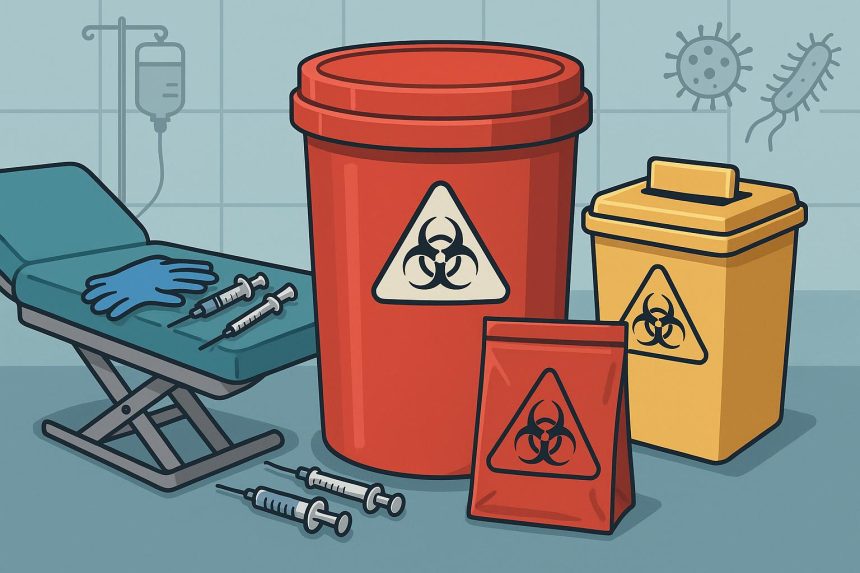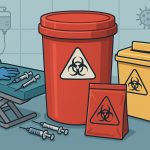Healthcare facilities generate tons of waste every single day, and much of it carries potential infection risks. When medical waste isn’t handled correctly, dangerous pathogens spread between patients, staff, and visitors. Cross-contamination remains one of the biggest threats to patient safety in hospitals and clinics worldwide. The good news? Most contamination events are completely preventable when facilities follow proven disposal protocols. From the moment a needle touches a sharps container to the final incineration of biohazardous materials, every step matters. This article breaks down practical strategies that healthcare facilities can implement immediately to protect everyone who walks through their doors.
Why Does Medical Waste Create Infection Risks?
Medical waste contains blood, bodily fluids, used bandages, and contaminated instruments. When these materials sit in open bins or get mixed with regular trash, pathogens easily transfer to clean surfaces. Healthcare workers handling improperly bagged waste can pick up infections on their gloves or clothing and then unknowingly carry those germs to patient care areas.
Quality surgical supplies for clinics and proper disposal equipment work together to create safer environments. Hospitals that use color-coded waste bags, puncture-resistant sharps containers, and sealed biohazard bins see significantly fewer contamination incidents.
What Happens When You Mix Waste Types?
Think about what happens when someone throws infectious waste into a regular trash bin. Staff members reaching into that bin expose themselves to needle sticks, cuts from broken glass, or contact with contaminated materials. Housekeeping teams face similar risks when they sort through mixed waste.
Every contamination point creates another opportunity for disease transmission. This is why separating waste at the source matters so much.
How Color-Coded Systems Prevent Mistakes?
Color-coded systems remove guesswork from waste disposal. Red bags signal biohazardous waste containing blood or body fluids. Yellow containers hold anatomical waste and pathological materials. Black or clear bags work for general non-hazardous waste like food wrappers and paper towels.
When every staff member understands the color system, mistakes drop dramatically. Nurses don’t wonder which bag to use for blood-soaked gauze. Lab technicians immediately know where culture plates belong.
Where to Place Waste Containers
You need to place clearly labeled containers in every room where medical procedures occur. Operating rooms need multiple waste stations within arm’s reach of the surgical table. Patient rooms require at least two types of bins. Labs should have separate containers for chemical waste, biological waste, and sharps.
Distance matters here. Staff shouldn’t walk more than a few steps to dispose of contaminated items. The farther someone carries infectious material, the higher the contamination risk.
What Your Staff Training Should Cover?
Even the best waste disposal system fails without proper staff training. Healthcare workers need regular instruction on infection control procedures, not just a quick orientation during their first week.
Effective training programs cover these essential topics:
- Proper hand hygiene before and after waste handling
- Correct techniques for removing contaminated gloves
- Safe methods for carrying waste bags without tearing
- Emergency procedures for spills or exposure incidents
Schedule quarterly refresher courses that include hands-on demonstrations. New employees should shadow experienced staff during their first waste disposal tasks.
How to Prevent Needlestick Injuries?
Needle sticks represent one of the most dangerous contamination risks in healthcare. A single stick can transmit hepatitis B, hepatitis C, or HIV. Proper sharps disposal eliminates most of these preventable injuries.
Mount puncture-resistant sharps containers at waist height in every room where injections occur. Never allow containers to fill beyond the marked line. Overstuffed containers force staff to push items down and risk getting stuck.
Why You Should Never Recap Needles?
Healthcare workers should never recap needles or remove them from syringes before disposal. The entire unit drops straight into the sharps container. This simple rule prevents thousands of injuries annually.
You want staff to develop muscle memory for safe disposal. When disposing of sharps becomes automatic, people make fewer mistakes even during stressful situations.
Best Routes for Transporting Medical Waste
Contamination often happens during waste transport, not at the point of disposal. You need dedicated transport routes that keep infectious materials away from clean areas like cafeterias, waiting rooms, and sterile supply rooms.
Designate specific elevators and hallways for medical waste movement. Schedule waste collection during low-traffic hours when possible. Train transport staff to use sealed carts with locking lids rather than open bins.
What to Do When Waste Bags Leak or Tear?
If a bag tears or leaks during transport, the spill stays contained within the cart. Document collection schedules so waste never sits in patient care areas overnight. Waste left for extended periods creates odor problems and increases contamination risk as bags deteriorate.
Having clear protocols for spills means your team responds quickly instead of panicking. Every minute contaminated material sits exposed increases the risk to everyone nearby.
How Often Should You Audit Waste Disposal?
Regular audits catch problems before they cause contamination events. Assign infection control staff to conduct monthly waste disposal inspections. Check if staff use correct containers, if they properly seal bags, and if waste areas stay clean and organized.
Track metrics like sharps container replacement frequency, waste bag tears or spills, and staff compliance rates. When numbers show declining performance, schedule additional training before a serious incident occurs.
Why Should Staff Feel Safe Reporting Problems?
Encourage staff to report disposal concerns without fear of punishment. Frontline workers often notice system flaws that administrators miss. A nurse who sees a frequently overfilled sharps container should be able to request additional units immediately.
Your goal is making it easy for people to speak up. When staff feel comfortable reporting problems, you fix issues before anyone gets hurt.
What to Look for in Waste Disposal Contractors?
Healthcare facilities can’t legally dispose of medical waste in regular landfills. Licensed contractors handle final treatment through incineration, autoclaving, or chemical disinfection. Choose contractors with proven track records and proper certifications.
Verify that contractors provide appropriate containers, maintain regular pickup schedules, and document waste treatment. Request manifests showing where waste goes and how it gets processed.
Planning for Contractor Delays
Establish backup contractors in case your primary service experiences delays. Medical waste can’t accumulate for weeks waiting for a late pickup. Having alternative arrangements prevents dangerous storage situations.
You stay legally responsible for your waste even after contractors haul it away. This makes contractor reliability a critical factor in your selection process.
Conclusion
Cross-contamination poses serious health risks, but effective medical waste disposal methods dramatically reduce transmission rates. Healthcare facilities that implement color-coded segregation systems, train staff consistently, maintain safe sharps protocols, and establish clear transport routes protect both patients and employees.
Regular auditing ensures these systems continue working properly over time. The investment in proper disposal equipment and staff education pays off through fewer infections, reduced liability, and improved safety outcomes. Every hospital and clinic can start improving their waste disposal practices today by evaluating current procedures, identifying gaps, and implementing proven contamination prevention strategies that save lives.
Lynn Martelli is an editor at Readability. She received her MFA in Creative Writing from Antioch University and has worked as an editor for over 10 years. Lynn has edited a wide variety of books, including fiction, non-fiction, memoirs, and more. In her free time, Lynn enjoys reading, writing, and spending time with her family and friends.















